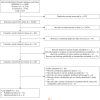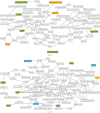Can joint fluid metabolic profiling (or "metabonomics") reveal biomarkers for osteoarthritis and inflammatory joint disease?: A systematic review
- PMID: 32435463
- PMCID: PMC7229296
- DOI: 10.1302/2046-3758.93.BJR-2019-0167.R1
Can joint fluid metabolic profiling (or "metabonomics") reveal biomarkers for osteoarthritis and inflammatory joint disease?: A systematic review
Abstract
Aims: Metabolic profiling is a top-down method of analysis looking at metabolites, which are the intermediate or end products of various cellular pathways. Our primary objective was to perform a systematic review of the published literature to identify metabolites in human synovial fluid (HSF), which have been categorized by metabolic profiling techniques. A secondary objective was to identify any metabolites that may represent potential biomarkers of orthopaedic disease processes.
Methods: A systematic review was conducted in accordance with Preferred Reporting Items for Systematic Reviews and Meta-Analysis (PRISMA) guidelines using the MEDLINE, Embase, PubMed, and Cochrane databases. Studies included were case series, case control series, and cohort studies looking specifically at HSF.
Results: The primary analysis, which pooled the results from 17 published studies and four meeting abstracts, identified over 200 metabolites. Seven of these studies (six published studies, one meeting abstract) had asymptomatic control groups and collectively suggested 26 putative biomarkers in osteoarthritis, inflammatory arthropathies, and trauma. These can broadly be categorized into amino acids plus related metabolites, fatty acids, ketones, and sugars.
Conclusion: The role of metabolic profiling in orthopaedics is fast evolving with many metabolites already identified in a variety of pathologies. However, these results need to be interpreted with caution due to the presence of multiple confounding factors in many of the studies. Future research should include largescale epidemiological metabolic profiling studies incorporating various confounding factors with appropriate statistical analysis to account for multiple testing of the data.Cite this article: Bone Joint Res. 2020;9(3):108-119.
Keywords: Inflammatory arthropathies; Metabolic profiling; Metabonomics; Osteoarthritis; Rheumatoid arthritis.
© 2020 Author(s) et al.
Conflict of interest statement
ICMJE COI statement: None declared
Figures


References
-
- Castañeda S, Roman-Blas JA, Largo R, Herrero-Beaumont G. Osteoarthritis: a progressive disease with changing phenotypes. Rheumatology (Oxford). 2014;53(1):1-3. - PubMed
-
- Johnson VL, Hunter DJ. The epidemiology of osteoarthritis. Best Pract Res Clin Rheumatol. 2014;28(1):5-15. - PubMed
-
- Scott DL, Wolfe F, Huizinga TW. Rheumatoid arthritis. Lancet. 2010;376(9746):1094-1108. - PubMed
-
- Cammarata RJ, Rodnan GP, Fennell RH. Serum anti-γ-globulin and antinuclear factors in the aged. JAMA. 1967;199(7):455-458. - PubMed
Publication types
LinkOut - more resources
Full Text Sources
Other Literature Sources

